浙江大学-海洋科学概论-海概复习总合集
海导题库浙江海洋学院海洋科学导论
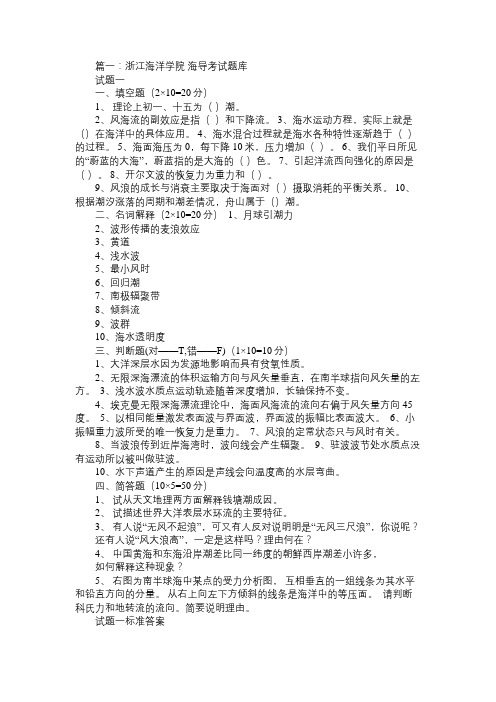
篇一:浙江海洋学院海导考试题库试题一一、填空题(2×10=20分)1、理论上初一、十五为()潮。
2、风海流的副效应是指()和下降流。
3、海水运动方程,实际上就是()在海洋中的具体应用。
4、海水混合过程就是海水各种特性逐渐趋于()的过程。
5、海面海压为0,每下降10米,压力增加()。
6、我们平日所见的“蔚蓝的大海”,蔚蓝指的是大海的()色。
7、引起洋流西向强化的原因是()。
8、开尔文波的恢复力为重力和()。
9、风浪的成长与消衰主要取决于海面对()摄取消耗的平衡关系。
10、根据潮汐涨落的周期和潮差情况,舟山属于()潮。
二、名词解释(2×10=20分) 1、月球引潮力2、波形传播的麦浪效应3、黄道4、浅水波5、最小风时6、回归潮7、南极辐聚带8、倾斜流9、波群10、海水透明度三、判断题(对——T,错——F)(1×10=10分)1、大洋深层水因为发源地影响而具有贫氧性质。
2、无限深海漂流的体积运输方向与风矢量垂直,在南半球指向风矢量的左方。
3、浅水波水质点运动轨迹随着深度增加,长轴保持不变。
4、埃克曼无限深海漂流理论中,海面风海流的流向右偏于风矢量方向45度。
5、以相同能量激发表面波与界面波,界面波的振幅比表面波大。
6、小振幅重力波所受的唯一恢复力是重力。
7、风浪的定常状态只与风时有关。
8、当波浪传到近岸海湾时,波向线会产生辐聚。
9、驻波波节处水质点没有运动所以被叫做驻波。
10、水下声道产生的原因是声线会向温度高的水层弯曲。
四、简答题(10×5=50分)1、试从天文地理两方面解释钱塘潮成因。
2、试描述世界大洋表层水环流的主要特征。
3、有人说“无风不起浪”,可又有人反对说明明是“无风三尺浪”,你说呢?还有人说“风大浪高”,一定是这样吗?理由何在?4、中国黄海和东海沿岸潮差比同一纬度的朝鲜西岸潮差小许多,如何解释这种现象?5、右图为南半球海中某点的受力分析图,互相垂直的一组线条为其水平和铅直方向的分量。
海洋科学导论期末复习整理

海洋科学导论期末复习整理地球科学体系定义:以人类之家――地球为研究对象的科学体系。
地球系统的复杂性导致研究其某一部分学科不断深入,发展成新的相对独立学科。
各学科相互交叉、渗透,又不断形成新的交叉、边缘学科。
如此,地球科学就组成了一个复杂的科学体系,包括地理学、地质学、大气科学、海洋科学、水文科学、固体地球物理学,以及与地球科学有密切关系的环境科学和测绘学。
地理学研究地球表面自然现象、人文现象以及它们之间相互关系和区域分异。
地球表面指大气圈、岩石圈、水圈、生物圈和人类圈相互交接的界面。
广义上,大气圈对流层顶部―岩石圈沉积岩层底部,厚度30~35km;狭义上,大气圈、岩石圈、水圈的交接面,上限小于100m,相当于对流层近地面摩擦层下部――地面边界层,下限为太阳辐射可能到达的深度,陆地30m,海洋200m,所以狭义的地球表面厚度一般不超过200~300m,人类活动最集中、最活跃的场所。
许多研究地球表面某一圈层或其中部分要素而原属于地理学范畴的学科,也已分出且进一步发展成与其他学科交叉渗透,从而形成了相对独立的学科,如大气科学、海洋科学和水文科学等。
地质学定义:是关于地球的物质组成、内部结构、外部特征、各圈层间的相互作用和演变历史的知识体系。
研究对象:地球的内、外圈层,矿物和岩石,地层和古生物,以及地质构造和地质作用等等。
由于观察和研究条件的限制,在现阶段仍主要是研究岩石圈,此外,也涉及大气圈、水圈、生物圈以及岩石圈以下更深的部位,甚至也包括某些地外物质。
定义:是地质学与物理学之间的边缘学科,研究各种地球物理场和地球的物理性质、结构、形成及其中发生的各种物理过程。
广义的地球物理学,除研究地球的固体部分外,还包括对水圈和大气圈的研究。
因为海洋科学、水文科学和大气科学业已各自发展成为独立学科,于是,致力于研究地球固体部分宏观物理学现象的分支,便成为狭义的地球物理学,或直接称为固体地球物理学。
大气科学定义:是研究大气的各种现象及人类活动对它的影响,这些现象的演变规律,以及如何利用这些规律为人类服务的综合性学科研究对象:主要是覆盖整个地球的大气圈,也包括太阳系其它行星的大气。
海洋科学导论复习题纲
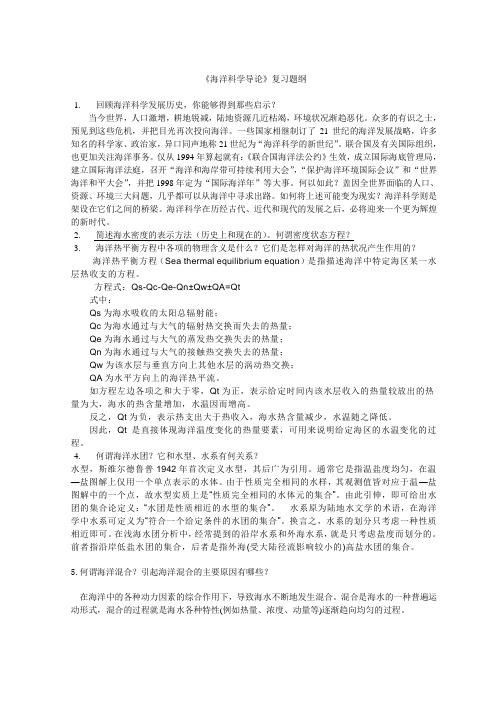
《海洋科学导论》复习题纲1. 回顾海洋科学发展历史,你能够得到那些启示?当今世界,人口激增,耕地锐减,陆地资源几近枯竭,环境状况渐趋恶化。
众多的有识之士,预见到这些危机,并把目光再次投向海洋。
一些国家相继制订了21世纪的海洋发展战略,许多知名的科学家、政治家,异口同声地称21世纪为“海洋科学的新世纪”。
联合国及有关国际组织,也更加关注海洋事务。
仅从1994年算起就有:《联合国海洋法公约》生效,成立国际海底管理局,建立国际海洋法庭,召开“海洋和海岸带可持续利用大会”,“保护海洋环境国际会议”和“世界海洋和平大会”,并把1998年定为“国际海洋年”等大事。
何以如此?盖因全世界面临的人口、资源、环境三大问题,几乎都可以从海洋中寻求出路。
如何将上述可能变为现实?海洋科学则是架设在它们之间的桥梁。
海洋科学在历经古代、近代和现代的发展之后,必将迎来一个更为辉煌的新时代。
2. 简述海水密度的表示方法(历史上和现在的)。
何谓密度状态方程?3. 海洋热平衡方程中各项的物理含义是什么?它们是怎样对海洋的热状况产生作用的?海洋热平衡方程(Sea thermal equilibrium equation)是指描述海洋中特定海区某一水层热收支的方程。
方程式:Qs-Qc-Qe-Qn±Qw±QA=Qt式中:Qs为海水吸收的太阳总辐射能;Qc为海水通过与大气的辐射热交换而失去的热量;Qe为海水通过与大气的蒸发热交换失去的热量;Qn为海水通过与大气的接触热交换失去的热量;Qw为该水层与垂直方向上其他水层的涡动热交换;QA为水平方向上的海洋热平流。
如方程左边各项之和大于零,Qt为正,表示给定时间内该水层收入的热量较放出的热量为大,海水的热含量增加,水温因而增高。
反之,Qt为负,表示热支出大于热收入,海水热含量减少,水温随之降低。
因此,Qt是直接体现海洋温度变化的热量要素,可用来说明给定海区的水温变化的过程。
4. 何谓海洋水团?它和水型、水系有何关系?水型,斯维尔德鲁普1942年首次定义水型,其后广为引用。
浙江大学-海洋科学概论-海概复习总合集
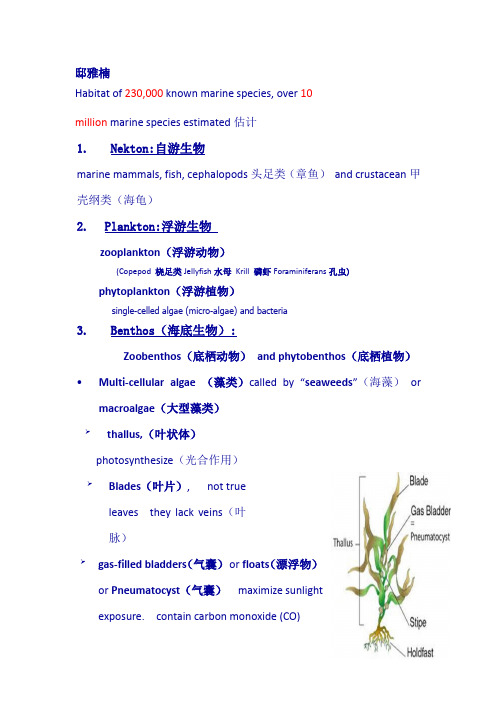
邸雅楠Habitat of 230,000 known marine species, over 10million marine species estimated估计1.Nekton:自游生物marine mammals, fish, cephalopods头足类(章鱼)and crustacean甲壳纲类(海龟)2.Plankton:浮游生物zooplankton(浮游动物)(Copepod 桡足类Jellyfish水母Krill 磷虾Foraminiferans孔虫)phytoplankton(浮游植物)single-celled algae (micro-algae) and bacteria3.Benthos(海底生物):Zoobenthos(底栖动物)and phytobenthos(底栖植物)•Multi-cellular algae (藻类)called by “seaweeds”(海藻)or macroalgae(大型藻类)➢thallus,(叶状体)photosynthesize(光合作用)➢Blades(叶片), not trueleaves they lack veins(叶脉)➢gas-filled bladders(气囊)or floats(漂浮物)or Pneumatocyst(气囊)maximize sunlightexposure. contain carbon monoxide (CO)➢the stipe(菌柄), not found on all seaweeds➢ A holdfast(固着器)holds the seaweed to the bottom. does not aid in gathering nutrientsChlorophyta = Green: Ulva(石莼/海白菜)Phaeophyta = Brown: Laminaria (海带)Rhodophyta = Red: Porphyra (紫菜)Flowering Plants(开花植物)•Over 250,000 species exist worldwide,only a few of these exist in the marine community•Those plants that do exist there must have mechanisms(结构)for dealing with salinity(盐分)。
公共基础知识复习资料:海洋科学基本知识之海、洋概观(精)
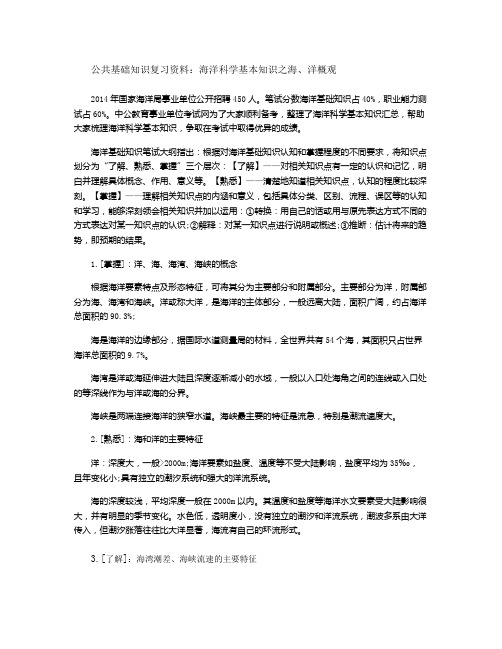
公共基础知识复习资料:海洋科学基本知识之海、洋概观2014年国家海洋局事业单位公开招聘450人。
笔试分数海洋基础知识占40%,职业能力测试占60%。
中公教育事业单位考试网为了大家顺利备考,整理了海洋科学基本知识汇总,帮助大家梳理海洋科学基本知识,争取在考试中取得优异的成绩。
海洋基础知识笔试大纲指出:根据对海洋基础知识认知和掌握程度的不同要求,将知识点划分为“了解、熟悉、掌握”三个层次:【了解】——对相关知识点有一定的认识和记忆,明白并理解具体概念、作用、意义等。
【熟悉】——清楚地知道相关知识点,认知的程度比较深刻。
【掌握】——理解相关知识点的内涵和意义,包括具体分类、区别、流程、误区等的认知和学习,能够深刻领会相关知识并加以运用:①转换:用自己的话或用与原先表达方式不同的方式表达对某一知识点的认识;②解释:对某一知识点进行说明或概述;③推断:估计将来的趋势,即预期的结果。
1.[掌握]:洋、海、海湾、海峡的概念根据海洋要素特点及形态特征,可将其分为主要部分和附属部分。
主要部分为洋,附属部分为海、海湾和海峡。
洋或称大洋,是海洋的主体部分,一般远离大陆,面积广阔,约占海洋总面积的90.3%;海是海洋的边缘部分,据国际水道测量局的材料,全世界共有54个海,其面积只占世界海洋总面积的9.7%。
海湾是洋或海延伸进大陆且深度逐渐减小的水域,一般以入口处海角之间的连线或入口处的等深线作为与洋或海的分界。
海峡是两端连接海洋的狭窄水道。
海峡最主要的特征是流急,特别是潮流速度大。
2.[熟悉]:海和洋的主要特征洋:深度大,一般>2000m;海洋要素如盐度、温度等不受大陆影响,盐度平均为35‰,且年变化小;具有独立的潮汐系统和强大的洋流系统。
海的深度较浅,平均深度一般在2000m以内。
其温度和盐度等海洋水文要素受大陆影响很大,并有明显的季节变化。
水色低,透明度小,没有独立的潮汐和洋流系统,潮波多系由大洋传入,但潮汐涨落往往比大洋显著,海流有自己的环流形式。
(完整版)海洋科学导论复习提纲汇总
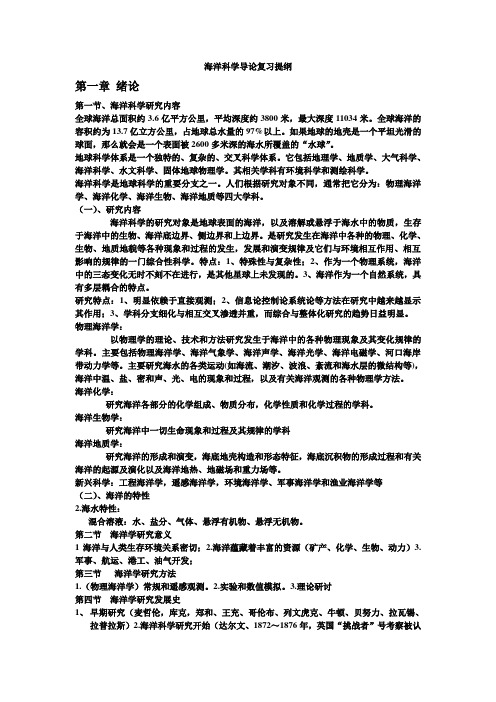
海洋科学导论复习提纲第一章绪论第一节、海洋科学研究内容全球海洋总面积约3.6亿平方公里,平均深度约3800米,最大深度11034米。
全球海洋的容积约为13.7亿立方公里,占地球总水量的97%以上。
如果地球的地壳是一个平坦光滑的球面,那么就会是一个表面被2600多米深的海水所覆盖的“水球”。
地球科学体系是一个独特的、复杂的、交叉科学体系。
它包括地理学、地质学、大气科学、海洋科学、水文科学、固体地球物理学。
其相关学科有环境科学和测绘科学。
海洋科学是地球科学的重要分支之一。
人们根据研究对象不同,通常把它分为:物理海洋学、海洋化学、海洋生物、海洋地质等四大学科。
(一)、研究内容海洋科学的研究对象是地球表面的海洋,以及溶解或悬浮于海水中的物质,生存于海洋中的生物、海洋底边界、侧边界和上边界。
是研究发生在海洋中各种的物理、化学、生物、地质地貌等各种现象和过程的发生,发展和演变规律及它们与环境相互作用、相互影响的规律的一门综合性科学。
特点:1、特殊性与复杂性;2、作为一个物理系统,海洋中的三态变化无时不刻不在进行,是其他星球上未发现的。
3、海洋作为一个自然系统,具有多层耦合的特点。
研究特点:1、明显依赖于直接观测;2、信息论控制论系统论等方法在研究中越来越显示其作用;3、学科分支细化与相互交叉渗透并重,而综合与整体化研究的趋势日益明显。
物理海洋学:以物理学的理论、技术和方法研究发生于海洋中的各种物理现象及其变化规律的学科。
主要包括物理海洋学、海洋气象学、海洋声学、海洋光学、海洋电磁学、河口海岸带动力学等。
主要研究海水的各类运动(如海流、潮汐、波浪、紊流和海水层的微结构等),海洋中温、盐、密和声、光、电的现象和过程,以及有关海洋观测的各种物理学方法。
海洋化学:研究海洋各部分的化学组成、物质分布,化学性质和化学过程的学科。
海洋生物学:研究海洋中一切生命现象和过程及其规律的学科海洋地质学:研究海洋的形成和演变,海底地壳构造和形态特征,海底沉积物的形成过程和有关海洋的起源及演化以及海洋地热、地磁场和重力场等。
浙江大学-海洋学院-地球系统概论-大洋环流-期末复习资料
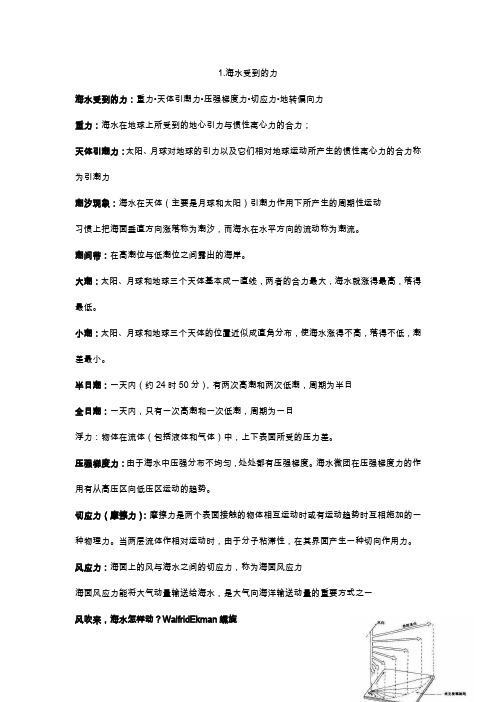
1.海水受到的力海水受到的力:重力•天体引潮力•压强梯度力•切应力•地转偏向力重力:海水在地球上所受到的地心引力与惯性离心力的合力;天体引潮力:太阳、月球对地球的引力以及它们相对地球运动所产生的惯性离心力的合力称为引潮力潮汐现象:海水在天体(主要是月球和太阳)引潮力作用下所产生的周期性运动习惯上把海面垂直方向涨落称为潮汐,而海水在水平方向的流动称为潮流。
潮间带:在高潮位与低潮位之间露出的海岸。
大潮:太阳、月球和地球三个天体基本成一直线,两者的合力最大,海水就涨得最高,落得最低。
小潮:太阳、月球和地球三个天体的位置近似成直角分布,使海水涨得不高,落得不低,潮差最小。
半日潮:一天内(约24时50分),有两次高潮和两次低潮,周期为半日全日潮:一天内,只有一次高潮和一次低潮,周期为一日浮力:物体在流体(包括液体和气体)中,上下表面所受的压力差。
压强梯度力:由于海水中压强分布不均匀,处处都有压强梯度。
海水微团在压强梯度力的作用有从高压区向低压区运动的趋势。
切应力(摩擦力):摩擦力是两个表面接触的物体相互运动时或有运动趋势时互相施加的一种物理力。
当两层流体作相对运动时,由于分子粘滞性,在其界面产生一种切向作用力。
风应力:海面上的风与海水之间的切应力,称为海面风应力海面风应力能将大气动量输送给海水,是大气向海洋输送动量的重要方式之一风吹来,海水怎样动?WalfridEkman螺旋假定在北半球稳定风场长时间作用在无限宽广、无限深海的海面上(海水密度均匀;海面水平;不考虑科氏力随纬度的变化;只考虑由铅直湍流导致的水平湍切应力),仅是风应力通过海面,借助水平湍切应力向深层传递动量而引起海水的运动,同时在运动过程中受到科氏力的作用,当科氏力与湍切应力取得平衡时,海流处于稳定状态。
在海平面,流速与海面上风应力成正比,同时也与地理纬度有关。
合成流右偏于风矢量方向45°。
当深度增大时,流速迅速减小,流向相对于风矢量逐渐右偏。
海洋概论提纲

基本概念海洋科学:是研究地球上海洋的自然现象、性质与其变化规律,以及和开发与利用海洋有关的知识体系。
大地水准面:全球静止海面是既不考虑地表海陆差异,也不考虑陆海地势起伏时的海面。
它在海洋中是不考虑波浪,潮汐和海流的存在,海水完全静止时的海面;它在大陆上是静止海面向大陆之下延伸的假想“海面”。
两者总称大地水准面,是陆上高程的起算面。
南大洋:从南极大陆到南纬40°为止的海域,或从南极大陆起,到亚热带辐合线明显时的连续海域。
(从海洋学的角度,一般把太平洋,大西洋和印度洋在南极洲附近连成一片的水域称为南大洋或南极海域)海水的盐度:1kg海水中将(Br-,I-)以氯置换,碳酸盐分解为氧化物,有机物全部氧化,所余固体物质的总克数。
单位是g/kg,用符号‰表示。
标准海水:国际上统一用一种氯度值为19.374‰,对应盐度值为35.000‰的大洋水作为标准,该大洋水为标准海水。
海水热容:海水温度升高一度时所吸收的热量,单位:J/℃。
位温:海洋中某一深度的海水微团,绝热上升到海面时所具有的温度称为该深度海水的位温,记为Θ海水状态方程:是描述海水状态参数之间关系的方程式。
(温度﹑压力和密度(或体积))大洋主温跃层:水温大体上随深度的增加呈不均匀递减。
低纬海域的暖水只限于薄薄的近表层之内,其下便是温度铅直梯度较大的水层,在不太厚的深度内,水温迅速递减,此层称为大洋主温跃层。
海水状态方程:描述海水状态参数温度(t)盐度(s)压力(p)与密度或比容之间相互关系的表达式。
(p-v-t)水团:源地和形成机制相近,具有相对均匀的物理、化学和生物特征及大体一致的变化趋势,而与周围海水存在明显差异的宏大水体。
(即水团内部的特征不要求绝对相同,只是“相近”、“相对均匀”、“大体一致”,但与周围水体差异必须是“明显”的。
)温-盐图解:(用于分析水团温盐特性的曲线)所谓T-S图解,系指以温度为纵坐标、以盐度为横坐标,将测站上不同层次的实测温、盐值对应地点在T-S坐标系中,然后自表至底有序地把各点联结起来的曲线(或折线)图。
- 1、下载文档前请自行甄别文档内容的完整性,平台不提供额外的编辑、内容补充、找答案等附加服务。
- 2、"仅部分预览"的文档,不可在线预览部分如存在完整性等问题,可反馈申请退款(可完整预览的文档不适用该条件!)。
- 3、如文档侵犯您的权益,请联系客服反馈,我们会尽快为您处理(人工客服工作时间:9:00-18:30)。
邸雅楠Habitat of 230,000 known marine species, over 10million marine species estimated估计1.Nekton:自游生物marine mammals, fish, cephalopods头足类(章鱼)and crustacean甲壳纲类(海龟)2.Plankton:浮游生物zooplankton(浮游动物)(Copepod 桡足类Jellyfish水母Krill 磷虾Foraminiferans孔虫)phytoplankton(浮游植物)single-celled algae (micro-algae) and bacteria3.Benthos(海底生物):Zoobenthos(底栖动物)and phytobenthos(底栖植物)•Multi-cellular algae (藻类)called by “seaweeds”(海藻)or macroalgae(大型藻类)➢thallus,(叶状体)photosynthesize(光合作用)➢Blades(叶片), not trueleaves they lack veins(叶脉)➢gas-filled bladders(气囊)or floats(漂浮物)or Pneumatocyst(气囊)maximize sunlightexposure. contain carbon monoxide (CO)➢the stipe(菌柄), not found on all seaweeds➢ A holdfast(固着器)holds the seaweed to the bottom. does not aid in gathering nutrientsChlorophyta = Green: Ulva(石莼/海白菜)Phaeophyta = Brown: Laminaria (海带)Rhodophyta = Red: Porphyra (紫菜)Flowering Plants(开花植物)•Over 250,000 species exist worldwide,only a few of these exist in the marine community•Those plants that do exist there must have mechanisms(结构)for dealing with salinity(盐分)。
•These plants have true leaves, stems, roots and conducting tissues—Mangrove trees (Rhizophora, 红树木科)—Seagrasses—Salt marsh PlantsAnimals1.1Classification of animals•phyla (界), and then classes, orders, families, genus, and speciesinvertebrate does not refer to a strictly defined scientific group, it is a handy term(随意的术语)meaning•Invertebrates are far more abundant in the ocean and on land than vertebrates are,about 97% of animals are invertebrates Sponges (海绵动物)Cnidarians (腔肠动物)Flatworms (扁形虫)Ribbonworms (纽虫)Nematodes (线虫)Annelids (环节动物)Sipunculans (星虫动物)Echiurans (螠虫动物)Molluscs (软体动物)Arthropods (节肢动物)Bryozoans (苔藓虫)Phoronids (帚虫)Brachiopods (腕足类)Arrow worms (箭虫)Echinoderms (棘皮动物)Hemichordates (半索海生动物)Tunicates (被囊动物)Lancelets (文昌鱼)Invertebrate—The SpongesInvertebrate—The Cnidarians(刺细胞)Includes Corals(珊瑚), Sea Anemones (海葵)and Jellyfish•Unique long stinging cells called:Cnidocytes (刺细胞)•Long harpoon(鱼叉)like tubes called:Nematocyst (刺丝囊)When the Nematocyst senses food is firesvenom outward to stun the prey(猎物)Barbs (倒钩) line the harpoon-tube to attachpreyStingsInvertebrate—The Molluscs(软体动物)Gastropods (腹足类, snails, sea slug海参); Bivalves (双壳类, oysters, clams, mussels); Cephalopods (头足类, octopus章鱼)4.1 Bivalves:双壳类•Clams, Oysters(牡蛎), Scallops, Mussels, etc.•Filter feeder(滤食动物)•Wide distributed and delicious4.2Gastropods(腹足类)•Coiled shell on most species4.3 Cephalopods(头足类)•All 650 species marine, including Squid(鱿鱼), Octopus,(章鱼)Nautilus (鹦鹉螺) & CuttlefishInvertebrate—The Arthropods(节肢动物)Marine fish are vertebrates•Some have vertebra made of cartilage (软骨), while others have bony (多骨的) vertebra (椎骨)•Among the 24,000 known species of fish, about 15,000 species are marine•Fish are the oldest of vertebrates (found farther back in the fossil record)About half of all vertebrate species are fish1. Agnatha (无颌鱼类)More Advanced Groups of Fish2.1 Chondrichthyes(软骨鱼纲)2.2 Osteichthyes, The Bony Fish(硬骨鱼纲)The Circulatory System Coloration•Two major theories about the origin of Life: Tradition of Creation and Theory of EvolutionApplication: Drugs origin from marine natural products1.List the differences between macroalgae and landplant?What is the basic body structure of Crustacean2.Classification of marine fish?•Classification of Marine lives•Macroalgae and Marine Plant•Marine Invertebrates•Marine Fish•Why learn Marine BiologyObjectives for this lecture:•At the end of this lecture, you should be able to:1.Know and understand the characteristics of microbes2.List the negative and positive effects of microbesWhy study MicrobiologyMicrobes (Microorganisms) are related to all life.–In all environments–Many beneficial aspects–Related to life processes (food, nutrientcycling)–Only a minority are pathogenic(致病的)Most of our problems are caused by microbesThe prominent characteristics of microbes are S mall, O ld, S imple(SOS)Discovery of Microorganisms1945Fleming, Chain, Florey Penicillin 青霉素Any extreme habitat—whether hot, cold, salty, acidic, alkaline, high pressure, oxygen- free, or toxic—is likely to harbormicrobes with special adaptions to theseconditions.Adaptation to Temperaturepsychro phile (嗜冷生物); meso phile (中温生物); thermo phile(嗜热生物)Adaptation to Oxygenobligate aerobe (需氧微生物)facultative anaerobe (兼型厌氧)true anaerobe(厌氧微生物)binary fission二分裂Disease/pathogen(致病源)Biofouling 生物污损Biodeterioration 生物腐蚀Ecosystem Service:(生态系统)Biogeochemistry Cycles=Biotic compartments = biosphere 生物圈Abiotic compartments = lithosphere 岩石圈atmosphere 大气圈hydrosphere 水圈益处Vaccination of finfish is widely used inaquaculture(长须鲸的疫苗广泛用于水产业)Applications of microbial biotechnology in Newapproaches to a ntifouling(微生物技术来防污)quorum quenching UacultureMarine microbes as sources for biofuels(生物能源)Pharmaceutical compounds from marine m icrobes(药物化合物)Enzymes from marine microbes(酶)Biotechnology(生物技术)Bioaugmentation 生物添加大陆地壳和洋壳:不仅仅是厚度不同Alfred Wegener, a German meteorologist (气象学家), proposed (提议) the continental drift hypothesis (大陆漂移学说) in 1912. The origin of continents and oceans (大陆和海洋的起源), Alfred Wegener, 1915.Territorial Sea: (领海)coastal country has full sovereignty over of the water.Contiguous Zone:(毗邻区)restrictive sovereignty(限制主权), some jurisdiction(司法)right for administration, such as anti-smuggling. (缉私)Exclusive Economic Zone:(经济专属区)coastal(沿海的)country has special rights over the exploration and use of marine resources.Continent Shelf(大陆架): EEZ stretched to this zone.EEZ and CS be stretched to 350 nm or more Beyond that, ISA:联合国国际海底管理局中国主张:自然延伸原则日本主张:中间线方法举例僧袍芋螺曲贝替定王品美马忠俊。
